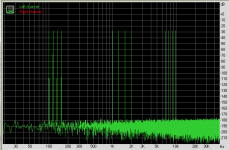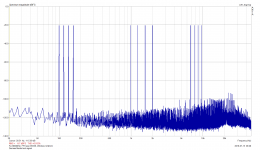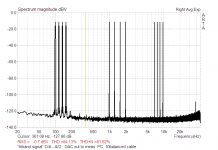To Joe R,: Has your summoned experts come to a conclusion regarding the topic that was discussed here the other month? I'm curious and I'm sure so are others. If I don't recall wrongly you where close to present a full written report - no?
//
//
Harbeth is an example of a lightweight loudspeaker with high cabinet radiation and has high regard whose trick is the subjective tuning of these cabinet behaviours.
Harbeth is an example of a lightweight loudspeaker with low cabinet radiation.
Thin wall cabinet design for low mass, selected damping for controlled resonances and care in reducing mechanical bridging between front/side/rear panels for control of mechanical vibration transfer.
You may check the cumulative spectral-decay plots (microphone and accelerometer derived) of it’s various models in Stereophile reviews.
Resonances low in intensity and short in time.
George
A quick comment on "hearing things at -120db"
1) when recording the original tracks lots of headroom is left so no clipping occurs, this varies a lot depending on the engineer but can often be 20 to 30 db depending.
2) 0VU is usually in the range of -18dbfs
3) in modern production (pop) styles the average level is increased to the top of the fs range, original noise floors follow upward.
4) some projects then get run thru a stereo tape recorder for that "sound", this will give you -70dbu noise or so.
in the final analysis, many things contribute to raising the original noise floor up in level so that things that were indeed at -120 dbfs are no longer so far down.
Cheers
Alan
1) when recording the original tracks lots of headroom is left so no clipping occurs, this varies a lot depending on the engineer but can often be 20 to 30 db depending.
2) 0VU is usually in the range of -18dbfs
3) in modern production (pop) styles the average level is increased to the top of the fs range, original noise floors follow upward.
4) some projects then get run thru a stereo tape recorder for that "sound", this will give you -70dbu noise or so.
in the final analysis, many things contribute to raising the original noise floor up in level so that things that were indeed at -120 dbfs are no longer so far down.
Cheers
Alan
The whole area of research into auditory perception is now somewhat critical of the simplistic test signals used for tests in the past & realize that complex signals can alter the results, significantly.
I don't see why this wouldn't apply to audio playback systems that are evaluated using the same auditory perceptual mechanisms.
The discussion of noise floors is a case in point - some seem to only consider measurements of averaged noise floor as relevant & don't seem to believe that there might be anything audible of value otherwise.
I don't see why this wouldn't apply to audio playback systems that are evaluated using the same auditory perceptual mechanisms.
The discussion of noise floors is a case in point - some seem to only consider measurements of averaged noise floor as relevant & don't seem to believe that there might be anything audible of value otherwise.
Last edited:
So you think that recordings do not have a noise floor in tens of dB higher than a good reproduction system.
So you think that recordings do not have a noise floor in tens of dB higher than a good reproduction system.
As I said, static, averaged noise floors measured using steady state test signals may well be a different thing to how systems handle dynamic signals with resultant noise floor modulation.
In other words the modulation aspect of the noise may be a very significant factor as far as auditory perception is concerned.
Demian’s triband test file, adapted for 96kHz sampling rate systems and 64k FFT length testing, no window function.
Dropbox - L+M+H (-6dB)_96kHz-64k FFT).wav - Simplify your life
(mono wav, 96kHz/24bit, 1min long)
Freq:
99.609, 117.188, 134.766, 158.203
987.305, 1245.117, 1570.313, 1983.398
6764.648, 7617.188, 8581.055, 9662.109
George
Dropbox - L+M+H (-6dB)_96kHz-64k FFT).wav - Simplify your life
(mono wav, 96kHz/24bit, 1min long)
Freq:
99.609, 117.188, 134.766, 158.203
987.305, 1245.117, 1570.313, 1983.398
6764.648, 7617.188, 8581.055, 9662.109
George
Attachments
I meant the hiss not pops and crackle, the things you mentioned even in small residual amounts are annoying.
If my dropbox account is still working I'll upload a fair use sized sample and you can see what you think. I do admire the level of OCD most restorers have. I just don't have the patience, but very glad they do.
To Joe R,: Has your summoned experts come to a conclusion regarding the topic that was discussed here the other month? I'm curious and I'm sure so are others. If I don't recall wrongly you where close to present a full written report - no?
//
Fair enough question. Things are still in a state of flux and a paper will be written. Like many things in science, these things take time and it is also about enjoying the journey, even if it can be rocky. Mostly forward, then a misstep mixed in here or there, but overall momentum ahead still achieved.
The basic proposition is an intriguing one: That dynamic loudspeakers are basically motors, that while it is driven by an AC voltage source (whether mains AC or constructed AC), the force factor in motors is the current flowing through the coil of the motor and not the voltage across its two terminals. Mechanical imperfections in the motor, such as resonances, does not disturb the voltage of a voltage source (an ideal voltage source), but it does affect the current of a voltage source.
Motors can have a number of issues that disturbs the current (one of our guys is an engineer with Transfield here in Australia and very knowledgeable about theses problems) and hence the motor runs "rough" - but it is actually worse than that, the voltage source has no control over the current, so the motor in effect pollutes its own source, it's own environment, it cannot stop by itself. So mechanical damping of the motor becomes critical.
So a motor resonance at a certain frequency, let us stipulate that it is a mechanical resonance, will cause the motor in itself to become a voltage source. It takes a bit of thinking, but the following has been confirmed to be correct, the reciprocal nature will be that the current gets modulated by that resonance. Since the motor's force is basically current, the resonance problem becomes magnified because the mechanical resonance becomes reflected on the current side which in turn affects the force, the current, and we have an ongoing event. Indeed in really bad cases, the motor can become destroyed or a very short life. The expression "you have a dirty motor" is both mechanical and electrical (current) in nature.
When a motor is running correctly, it is the current that is the force, not the voltage. Reverse that, make the motor move smoothly (from a turbine for example) and we have an AC voltage source, a generator. A resonance will show up as a voltage source and when out motor is force driven from another voltage source, then examine closely what happens to the current. It is not pretty.
When you translate these factors to speakers as motors, we are struck by the fact that a resonance (or any imperfection in the speaker) will create a distorted current of the amplifier.
So here is an interesting hypothesis: That an imperfection in the driver cannot change the voltage of an ideal voltage source, but it can change the current and once the current has changed, then the speaker will respond to that altered current, further altering that current and... we have time smear until the content (usually music) has subsided. Hence we are listening to the current of the amplifier and not the voltage.
Yes, that hypothesis has generated interest. But somehow I also think it will generate scorn here among some in the lounge. But as Solomon said, one face sharpens that of another. So I am open to constructive suggestions, but have become impervious to the ridicule. Seems to go with the territory.
Dan and I have spoken on the phone at different times, I think he is in the 'black art' camp (I mean no scorn and he may correct me on that) and I am not. I just want to make that differentiation. I am interested in the science, measurements and mathematics and all that - and the people I collaborate with on this topic are of the same ilk. I don't want to mention names here, but they know who they are, at least three of them are physicists.
I believe that 'black art' in speakers can be explained, they come down to the way that speakers interface with amplifiers, which are universally voltage sources. Certain approaches gets things more right than wrong and somehow 'sounds' better, but without any actual resolution of what is going on.
That is an ongoing quest and when resolved we may end up knowing more about speakers and curiously also more about amplifiers - that we may end up with a better and more focused way of designing amplifiers. In a marriage it is dangerous to focus on one and not the other. 😉
How quick can an amplifier stop current, when musical content subsides or stops? It matters to the speaker, because what the amplifier does on the current side, it will also do, then feed that back and we have a near vicious circle. Then the speakers are producing a time smeared version of the musical content.
And we haven't even discussed crossovers and how that affects things. They are modelled according to the voltage model, but in fact, from the driver's point of view, the crossover parcels out current to different drivers. They are current crossovers, not voltage crossovers, yet we still look it as being the latter, but clearly that needs to be questioned.
So once we start looking at the role of crossovers, the variables expands exponentially, because we have many orders, both parallel and series (series may prove to be superior, but most speakers use parallel).
Finally, as I stated earlier, any driver has two parts to its impedance (as we look at the impedance plot), the Re or DC resistance of the voice coil and flat across all frequencies and any measured impedance above Re is the back-EMF part of the impedance. One part dissipates heat, the back-EMF is caused by the 'motor' being a voltage source and the back-EMF can be motional, inductive and microphonic (a resonance, no matter how small, becomes a microphonic voltage source and that is not speculation). The back-EMF impedance is crucial to understanding what is happening, because it is that part of the impedance that has the potential to change the current of the amplifier - and what we hear! That back-EMF has a specific numeric value at any given frequency, so it can be used mathematically and becomes very important.
So this is a huge subject, interest in growing, those who used to talk about current driving loudspeakers, but often begged off, but sometimes these things to find their time, and that time seems to be now. And it is both challenging, intriguing and more, all at the same time.
Now it is best for me to get to work (AM here) and find out later what the fallout will be. 😉
Cheers, Joe R.
Now it is best for me to get to work (AM here) and find out later what the fallout will be. 😉
Cheers, Joe R.
I see nothing has changed. You promised to measure the distortion last time.
Last edited:
Then what is it a problem with? Almost every good part has better than 120 dB SNR. Of course you come to just obfuscate and cast doubt without offering anything.
I offered an example, what's your example of the problem?
Sorry, from what I can see, you offered nothing more than a sarcastic reply to Marks post Chris. Quoted below. Try to be nice to people for a change, even those that you don't necessarily agree with, you will feel better about yourself. Mark's very passionate about his DAC development work, we should be encouraging him, we might learn something.
Originally Posted by Markw4 View Post Don't know about speaker destruction, but being deafened when attempting near field critical listening could be an issue. I tend to listen at much lower levels than the system is capable of. Turn it up to impress visitors.
Posted by Chris719 Yeah, hearing damage works too. I'd love to see someone demonstrate their ability to hear noise floor modulation on an AK4499 DAC in mono mode.
To further my comment on AK4499, it looks like AKM may have actually improved noise floor modulation over the ESS Pro. The AKM Eval board data sheet shows very little and that may be mostly due to AP test set ADC.
Again whether you can hear it is the question. Rob Watts reckons it's audible down to very low levels. I posted the original link to his 'DAC design master class' video, predictably it was slammed here. Just another quick comment WRT modern recordings noise floor. These days, with the advent of DAW's, the track count can be huge, easily well over 60. If the engineer gets slack with muting of unused tracks, that can also result in quite a build up of noise.
T
What is there that professional DAC designers haven't learned on audible sound quality?Mark's very passionate about his DAC development work, we should be encouraging him, we might learn something.
Sorry, from what I can see, you offered nothing more than a sarcastic reply to Marks post Chris. Quoted below. <snip>
One thing we don't need is your armchair psychological ad-hominem.
I have never seen noise modulation measured in any audio DAC datasheet, to my knowledge. Can you link it? I would never discourage anyone from actually performing measurements or doing research.
Still, I have seen not a single shred of evidence that this is audible, nevermind a problem. Your "evidence" is yet another argument from authority. There are a lot of laughable things in that Rob Watts video. He's no doubt intelligent, but also either delusional or intentionally deceptive.
What is there that professional DAC designers haven't learned on audible sound quality?
Probably nothing. I'd put the odds of some significant discovery coming out of this forum near the odds of capturing a live Bigfoot, Loch Ness Monster, or a chupacabra.
Last edited:
Demian’s triband test file, adapted for 96kHz sampling rate systems and 64k FFT length testing, no window function.
Dropbox - L+M+H (-6dB)_96kHz-64k FFT).wav - Simplify your life
That's a good test signal, thank you for a reminder, George.
Demian’s triband test file, adapted for 96kHz sampling rate systems and 64k FFT length testing, no window function.
George
Is the plot digital or DA-AD? I see no artifacts above -170 dB? Does ARTA have a peak hold on the FFT?
I tried the file on some of my hardware and I'm getting odd results. With two different AD-DA and two different software packages I get flawless digital loopback and really substantial frequency response errors on analog loopback. I will setup with different hardware tomorrow if I have time and then post results.
Is the plot digital or DA-AD?
It looks like signal analysis, not D/A - A/D.
I am attaching the "real thing", mediocre one.
Attachments
In both posts (post 24976 for the 48kHz SR and post 25131 for the 96kH SR) the FFT screenshot (65536 samples, no window) is from the digital test file.
I will try to build another test file for 44.1kHz SR systems.
Card Loopback and systems tests are for a later time.
George
I will try to build another test file for 44.1kHz SR systems.
Card Loopback and systems tests are for a later time.
George
Perhaps you could now try to be a little more specific?
Ok, thanks Joe, that's as clear as......................I see nothing has changed. You promised to measure the distortion last time.
I agree that if the system is "good", then this signal shows nothing more than 3 single sines and a 19+20kHz CCIF. If the system is "bad", then some artifacts may be visually more evident, however the non-linearity is always the same and the system does not know how "complex" the signal looks to human eye. Steady state x "dynamic" signals debate is a nonsense.
BTW, the window should be uniform and 64k FFT used, at 96 kHz, for proper resolution.
BTW, the window should be uniform and 64k FFT used, at 96 kHz, for proper resolution.
- Status
- Not open for further replies.
- Home
- Member Areas
- The Lounge
- John Curl's Blowtorch preamplifier part III


